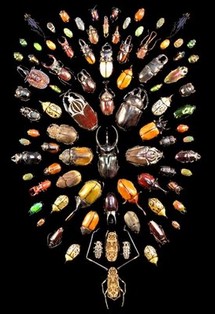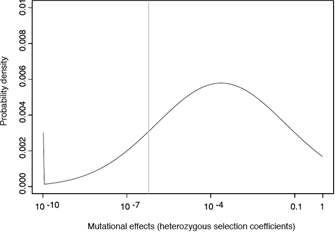what kind of mutation has no effect on an organisms ability to survive or reproduce?
Is it possible to have "too many" mutations? What virtually "likewise few"? While mutations are necessary for development, they tin can damage existing adaptations also.
What is a mutation?

The diversity of beetle species.
Genetic mutation is the basis of species diversity amongst beetles, or whatsoever other organism.
© 2009 Courtesy of John C. Abbot, Abbott Nature Photography. All rights reserved. ![]()
Mutations are changes in the genetic sequence, and they are a main crusade of diversity among organisms. These changes occur at many different levels, and they can have widely differing consequences. In biological systems that are capable of reproduction, we must first focus on whether they are heritable; specifically, some mutations affect only the private that carries them, while others affect all of the carrier organism's offspring, and farther descendants. For mutations to affect an organism's descendants, they must: 1) occur in cells that produce the next generation, and 2) touch on the hereditary textile. Ultimately, the interplay betwixt inherited mutations and environmental pressures generates diverseness among species.
Although diverse types of molecular changes exist, the word "mutation" typically refers to a change that affects the nucleic acids. In cellular organisms, these nucleic acids are the building blocks of DNA, and in viruses they are the building blocks of either Dna or RNA. One way to think of DNA and RNA is that they are substances that carry the long-term retentivity of the information required for an organism'due south reproduction. This article focuses on mutations in Dna, although nosotros should go on in mind that RNA is subject to essentially the aforementioned mutation forces.
If mutations occur in non-germline cells, and so these changes can exist categorized as somatic mutations. The word somatic comes from the Greek word soma which means "body", and somatic mutations only touch on the present organism's body. From an evolutionary perspective, somatic mutations are uninteresting, unless they occur systematically and alter some fundamental property of an private--such as the chapters for survival. For case, cancer is a potent somatic mutation that volition affect a unmarried organism'due south survival. As a different focus, evolutionary theory is mostly interested in Deoxyribonucleic acid changes in the cells that produce the next generation.
Are Mutations Random?
The argument that mutations are random is both greatly true and profoundly untrue at the aforementioned time. The true aspect of this statement stems from the fact that, to the best of our knowledge, the consequences of a mutation accept no influence whatsoever on the probability that this mutation will or will not occur. In other words, mutations occur randomly with respect to whether their effects are useful. Thus, beneficial DNA changes do not happen more oft simply considering an organism could benefit from them. Moreover, even if an organism has caused a benign mutation during its lifetime, the corresponding information will not menses back into the DNA in the organism's germline. This is a key insight that Jean-Baptiste Lamarck got wrong and Charles Darwin got right.
However, the idea that mutations are random tin can be regarded equally untrue if one considers the fact that not all types of mutations occur with equal probability. Rather, some occur more frequently than others considering they are favored by low-level biochemical reactions. These reactions are too the main reason why mutations are an inescapable property of any organization that is capable of reproduction in the existent earth. Mutation rates are usually very low, and biological systems go to extraordinary lengths to keep them every bit low equally possible, more often than not because many mutational effects are harmful. Notwithstanding, mutation rates never reach naught, even despite both depression-level protective mechanisms, similar DNA repair or proofreading during DNA replication, and high-level mechanisms, like melanin deposition in skin cells to reduce radiation harm. Beyond a sure betoken, fugitive mutation simply becomes likewise costly to cells. Thus, mutation will always be present as a powerful force in evolution.
Types of Mutations
So, how practise mutations occur? The respond to this question is closely linked to the molecular details of how both Deoxyribonucleic acid and the entire genome are organized. The smallest mutations are point mutations, in which just a single base of operations pair is inverse into another base of operations pair. Withal some other type of mutation is the nonsynonymous mutation, in which an amino acid sequence is changed. Such mutations lead to either the production of a different poly peptide or the premature termination of a protein.
Every bit opposed to nonsynonymous mutations, synonymous mutations do not change an amino acid sequence, although they occur, by definition, just in sequences that code for amino acids. Synonymous mutations be because many amino acids are encoded by multiple codons. Base pairs tin can too take various regulating properties if they are located in introns, intergenic regions, or even within the coding sequence of genes. For some historic reasons, all of these groups are often subsumed with synonymous mutations nether the label "silent" mutations. Depending on their function, such silent mutations can exist anything from truly silent to extraordinarily important, the latter implying that working sequences are kept constant by purifying selection. This is the most likely caption for the existence of ultraconserved noncoding elements that have survived for more than 100 million years without substantial change, as establish past comparing the genomes of several vertebrates (Sandelin et al., 2004).
Mutations may too take the grade of insertions or deletions, which are together known every bit indels. Indels tin can have a wide variety of lengths. At the short end of the spectrum, indels of 1 or ii base of operations pairs within coding sequences have the greatest effect, because they volition inevitably crusade a frameshift (merely the addition of one or more three-base-pair codons will continue a poly peptide approximately intact). At the intermediate level, indels tin touch on parts of a cistron or whole groups of genes. At the largest level, whole chromosomes or even whole copies of the genome tin can exist affected by insertions or deletions, although such mutations are usually no longer subsumed under the characterization indel. At this high level, information technology is also possible to invert or translocate entire sections of a chromosome, and chromosomes tin can even fuse or break apart. If a big number of genes are lost as a effect of i of these processes, and then the consequences are usually very harmful. Of course, unlike genetic systems react differently to such events.
Finally, still other sources of mutations are the many different types of transposable elements, which are modest entities of DNA that possess a mechanism that permits them to movement around within the genome. Some of these elements copy and paste themselves into new locations, while others utilise a cutting-and-paste method. Such movements can disrupt existing cistron functions (by insertion in the eye of another gene), actuate dormant gene functions (by perfect excision from a gene that was switched off by an before insertion), or occasionally lead to the product of new genes (by pasting fabric from dissimilar genes together).
Furnishings of Mutations

A unmarried mutation can take a large effect, but in many cases, evolutionary change is based on the aggregating of many mutations with small effects. Mutational effects tin exist beneficial, harmful, or neutral, depending on their context or location. Near non-neutral mutations are deleterious. In general, the more base of operations pairs that are affected by a mutation, the larger the outcome of the mutation, and the larger the mutation'due south probability of being deleterious.
To better sympathize the impact of mutations, researchers have started to gauge distributions of mutational effects (DMEs) that quantify how many mutations occur with what outcome on a given property of a biological system. In evolutionary studies, the property of involvement is fitness, just in molecular systems biological science, other emerging properties might also exist of interest. It is extraordinarily difficult to obtain reliable information about DMEs, because the corresponding effects span many orders of magnitude, from lethal to neutral to advantageous; in addition, many confounding factors ordinarily complicate these analyses. To make things even more difficult, many mutations also interact with each other to alter their effects; this phenomenon is referred to as epistasis. However, despite all these uncertainties, recent work has repeatedly indicated that the overwhelming majority of mutations take very modest effects (Figure 1; Eyre-Walker & Keightley, 2007). Of course, much more than piece of work is needed in lodge to obtain more detailed information most DMEs, which are a fundamental property that governs the evolution of every biological system.
Estimating Rates of Mutation
Many direct and indirect methods accept been developed to aid estimate rates of dissimilar types of mutations in various organisms. The main difficulty in estimating rates of mutation involves the fact that DNA changes are extremely rare events and can just be detected on a background of identical Deoxyribonucleic acid. Because biological systems are commonly influenced by many factors, straight estimates of mutation rates are desirable. Straight estimates typically involve use of a known pedigree in which all descendants inherited a well-defined Deoxyribonucleic acid sequence. To measure mutation rates using this method, ane first needs to sequence many base of operations pairs within this region of DNA from many individuals in the pedigree, counting all the observed mutations. These observations are then combined with the number of generations that connect these individuals to compute the overall mutation rate (Haag-Liautard et al., 2007). Such directly estimates should not exist confused with substitution rates estimated over phylogenetic time spans.
Summary
Mutation rates can vary within a genome and between genomes. Much more work is required before researchers can obtain more than precise estimates of the frequencies of unlike mutations. The ascension of high-throughput genomic sequencing methods nurtures the hope that we volition exist able to cultivate a more detailed and precise agreement of mutation rates. Considering mutation is one of the fundamental forces of evolution, such work will go on to be of paramount importance.
References and Recommended Reading
Drake, J. West., et al. Rates of spontaneous mutation. Genetics 148, 1667–1686 (1998)
Eyre-Walker, A., & Keightley, P. D. The distribution of fettle effects of new mutations. Nature Reviews Genetics 8, 610–618 (2007) doi:10.1038/nrg2146 (link to article)
Haag-Liautard, C., et al. Direct estimation of per nucleotide and genomic deleterious mutation rates in Drosophila. Nature 445, 82–85 (2007) doi:10.1038/nature05388 (link to article)
Loewe, L., & Charlesworth, B. Inferring the distribution of mutational effects on fettle in Drosophila. Biology Messages two, 426–430 (2006)
Lynch, Thousand., et al. Perspective: Spontaneous deleterious mutation. Evolution 53, 645–663 (1999)
Orr, H. A. The genetic theory of adaptation: A brief history. Nature Review Genetics 6, 119–127 (2005) doi:10.1038/nrg1523 (link to article)
Sandelin, A., et al. Arrays of ultraconserved non-coding regions bridge the loci of cardinal developmental genes in vertebrate genomes. BMC Genomics five, 99 (2004)
Source: http://www.nature.com/scitable/topicpage/genetic-mutation-1127
0 Response to "what kind of mutation has no effect on an organisms ability to survive or reproduce?"
Post a Comment